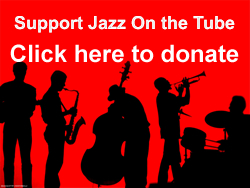We’ve been focusing on the golden age of Cuban big bands which means we’ve looked at Cuban musicians who left Cuba and “colonized” places like Mexico City and New York City in the 1940s and 1950s.
It makes sense because, after all, Jazz on the Tube is a jazz site.
Also, as for every subject, there are certain foundational musicians you just have to know.
In a world as rich as Cuban music, we haven’t cover them all, but we’ve made a start.
But now we’re going to focus on Cuba and Cuba today.
Introducing Los Muñequitos de Matanzas…
This video introduces us to a number of important topics:
Rumba – Not to be confused with the popular American dance rhumba
Matanzas – An historically important cultural center of Cuba, sixty-three miles east of Havana by car. It’s been called “The Athens of Cuba.”
Los Muñequitos De Matanzas – One of the great rumba groups of Cuba which has been recording continuously since 1956.
The group is actually a full blown cultural institution as this video shows. It not only performs and records, it also has an active education and training program for young people.
Congahead – This particular video came from the YouTube channel of Latin Percussion, the world’s leading maker of Latin percussion instruments. It is a treasure trove of content.
The roots of rumba
It’s often said that “rumba” means “party.” Robert Farris Thompson says it comes from a verb meaning to “to work it.” I think Thompson’s definition is much closer to the mark.
Rumba is singing, drumming and dancing. It has absolutely nothing to do with the “rhumba” style of ballroom dancing that was invented to cash in on the Cuban music craze of the 1920 and 30s.
Rumba was developed by the dock workers of Havana and Matanzas.
In our age of container shipping, forklifts and modern cranes, it’s easy to forget that until fairly recently everything shipped had to be personally hauled by a human being. This created a huge work force of dockworkers all over the world (now massively reduced by the modern technology.)
In the long slavery era, this work was done in Cuba by enslaved people from Africa. As best as we understand, the rumba was created in the mid 19th century when Cuba was experiencing a particularly virulent form of slavery built around the brutal sugar trade. Mantazas was one of the main centers of this trade.
Who are Los Muñequitos De Matanzas?
Like all great art, you’ll get far more from Los Muñequitos by experiencing them than from hearing someone talk about them, but they do have a fascinating history.
Muñequitos means “little dolls” but it can also mean comic book superheroes and that’s the meaning behind the group’s name .
We pinched this from wikipedia because it tells the story of the groups origins so well.
On October 9, 1952 in the barrio of La Marina, city of Matanzas, Cuba, a group of young rumberos stopped off at their local tavern El Gallo after work. While unwinding over drinks, a song by Arsenio Rodríguez came on the bar’s record player. The drummers began accompanying the song by playing on the counter, on glasses and bottles, using whatever items were at hand. Their performance so impressed the other customers, as well as passers-by, that the men received applause when the song and their accompaniment concluded. It was at that moment when one of the men suggested they form a rumba group to perform at local venues. It was agreed and the rumberos walked over to the house of singer and composer Florencio Calle “Catalino” to enlist his help. After hearing the men’s proposition Catalino told them to return the next day to discuss the matter.
At the meeting the following day, Grupo Guaguancó Matancero was formed. The men agreed that the group would perform rumba and each member would be responsible for bringing his own respective instrument. The original members of Guaguancó Matancero were Florencio Calle “Catalino” (director, guagua), Esteban Lantri “Saldiguera” (vocalist), Juan Bosco (vocalist, claves), Hortensio Alfonso “Virulilla” (vocalist, maraca), Gregorio Díaz “Goyo” (tumba or salidor), Pablo Mesa “Papi” (segundo or tres dos) and Angel Pellado “Pelladito” (quinto). Later that year the great batalero (‘batá drummer’) and quintero (‘quinto drummer’) Esteban Vega “Chachá” joined the group.
Although the members were all genuine “street” rumberos, they began performing on stage from the group’s inception. Saldiguera and Virulilla who had sung in son septetos (‘septets’), brought that genre’s style of harmony singing to the group. The percussion was of a very high quality, with the drums carrying on “conversations” of unprecedented inventiveness and virtuosity. The drums were tuned much lower back then, sounding like funky bass lines, with the rhythmically elusive singing “floating” on top. Initially, the group only performed guaguancó, but in ensuing years they interpreted yambú, columbia and abakuá as well.
If you’re curious about the little girl – and who wouldn’t be? – she was four years old at the time of this filming and is a family member of one of the group’s founding members.
Will Afro-Cuban culture will survive in Cuba? She is a partial answer.
When touring western Cuba with Ned Sublette in March of 2016, we got to see Los Muñequitos perform in their home town, on their home street, right in front of their school.
It was pure magic and if that had been the only thing that happened on the trip, the whole trip would have been worthwhile.
The very first short segment of this “highlights reel” clip shows members of the dance school performing that evening.
Archival footage of Los Muñequitos
– Ken McCarthy
Jazz on the Tube
P.S. Our unique programming is made possible by help from people like you. Learn how you can contribute to our efforts here: Support Jazz on the Tube
Thanks.





